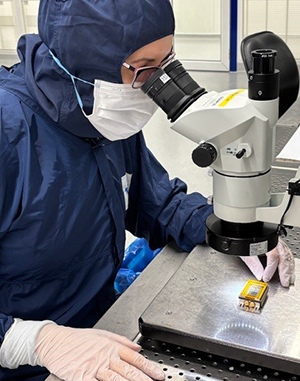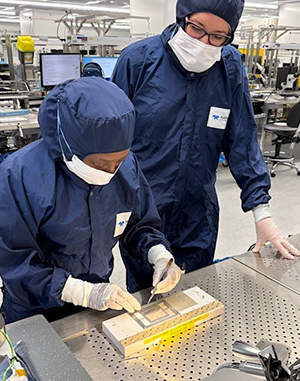Q: What sort of work do the teams that you oversee carry out?
The wafer fabrication team use silicon processing techniques to manufacture our CCD devices from silicon wafers. Backthinning is a quite a niche area for the industry; we backthin our own CCDs, but also CMOS devices supplied to us. We assemble the devices into custom and off-the-shelf packages and carry out camera tests, with our own custom-made cameras, to verify the product.
Our team members need to adhere to the given time frames to ensure that we deliver on what we have promised to our customers and ensure processes are followed correctly so that we meet the correct quality standards. We monitor these, as well as other aspects, throughout manufacturing.
Q: That’s quite a few teams you are managing. How many people are involved?
A: In total, I manage 36 people. We're focusing quite heavily on cross training across our teams so that we can have a flexible workforce in the future. Our target state is to be able to move people from one area to another, to better manage workload in key areas, when needed.
Q: A lot of your work is based in the cleanrooms at Teledyne Space Imaging. What exactly are cleanrooms and how do they work?

A cleanroom is a sealed-off area that has filters and air circulation that maintains a certain level of cleanliness. Some areas are specified as class five cleanrooms, while others, such as our wafer fabrication facilities, are class six, which is even cleaner. You are not allowed to bring any paper, tissues, books etc. into a clean room and you cannot smoke or vape for four hours before entering due to possibly having particulates on your breath. You can't wear makeup in a cleanroom either. We have two main suites of cleanrooms here in Space Imaging, made up of around 25 cleanrooms between them.
Cleanliness is hugely important in this industry. For the wafer processing area cleanliness is critical to ensure the quality of the devices. In post-processing assembly and test, because many of our products go into space and we must make sure there is no dust or particulates on the surface of the device. If a particle of dirt or dust were to attach itself to one of the pixels in a sensor that was designed to view an area of interest in space, there's no opportunity to go back and rectify that. So, we have to make sure from the start that we don't introduce any kind of contamination in order to protect the devices while they are being manufactured. All individuals working within the cleanrooms wear overalls, hoods and boots plus gloves and facemasks to ensure there is no risk of particles shedding.

Q: What is it like working in the cleanrooms at Teledyne Space Imaging?
People don't tend to think about cleanrooms when they think about careers in space. Personally, I love it! When I joined Teledyne as a process engineer, I was based in the cleanroom all day, every day and absolutely loved it.
I still find it exciting. No two days are the same and, certainly as an engineer, you're looking at, for example, nonconformities and investigating those, it’s an exciting place to work. We're always pushing the technology we use and working to improve on what we've been doing to date. When you get to work with so many different processes, there are no opportunities to get bored!
It can be quite demanding, when you are doing highly detailed work, such as some of the clean and inspection. You need to take regular breaks and work on a mixture of tasks throughout the day so that you don’t spend too long doing something that is very focused and intense.
Q: How would you advise younger people who are interested in a career in space, or in working in cleanrooms? What would they need to study to get started?

It depends on which area you would want to work in. Within manufacturing, Electronics and Mechanical Engineering qualifications are preferred. Equally, apprenticeships are another really good way to begin your career. We offer a fantastic apprenticeship scheme at Teledyne Space Imaging. By offering young people from all sorts of backgrounds the chance to train in different areas of engineering within Space Imaging, we can provide them with a well-rounded basis to focus their efforts on the areas that they especially enjoyed later on.
We have various levels of apprentices. Some might take on an operator type of role progressing through to Technician level. Others might join us as a technician or junior engineer and work towards a Degree apprenticeship.
Q: What have some of the most exciting aspects of your work at Teledyne Space Imaging been?
I love knowing I’ve contributed to products that will be out there in space one day. I enjoy challenging work; products that have highly exacting specifications and technical demands.
Every day really is a school day here. We are learning all the time. Some of my favourite days have been where we've been investigating nonconformities and working out why something is not quite right. It’s like an investigation where we have to look into potential root causes. We work in a multidisciplinary team and are always sharing ideas. What we may discover between us could make a huge difference to the overall success of a project and that is a really exciting prospect for me.
